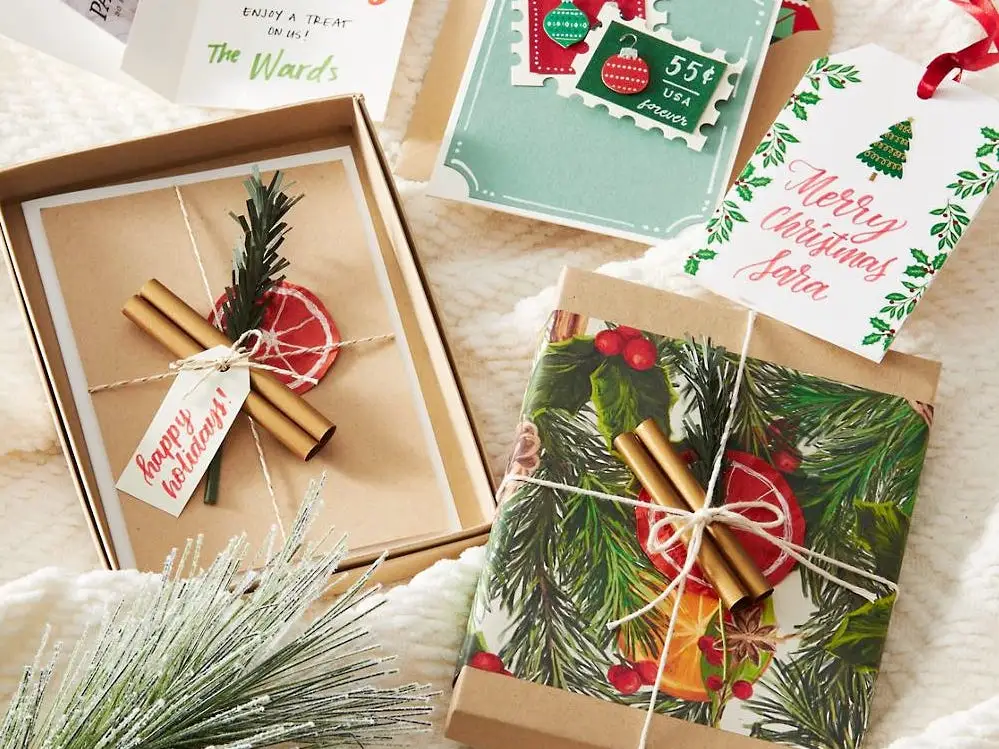
Sustainable Wrapping Paper Alternatives
Sustainable Wrapping Paper Alternatives are eco-friendly alternatives to traditional wrapping paper that are more eco-conscious and have a lower environmental impact. Many people are looking for ways to reduce their carbon footprint and make a positive impact on the environment as awareness of environmental issues and the need for sustainability grows. Alternatives to wrapping paper is a common items used during gift-giving occasions, but their production and disposal can have negative environmental consequences. Individuals can reduce waste, conserve resources, and support environmentally friendly practices by using sustainable alternatives.
Reusable cloth gift bags are one of the most popular alternatives to wrapping paper. These bags are available in a range of sizes and styles and can be used year after year. They can be made from a variety of materials, including cotton, canvas, and even recycled materials, and are an excellent choice for those looking to reduce waste.
Sustainable wrapping paper is a greener alternative because it is made from recycled, biodegradable, or eco-friendly materials. This type of wrapping paper reduces waste and conserves natural resources, making it a more environmentally responsible option for gift wrapping.
What are some common sustainable wrapping paper alternatives?
- Reusable cloth
- Recycled paper
- Biodegradable paper
- Newspaper or magazine pages
- Tins, Cans, or Jars
- Paper Grocery Bags.
- Reusable Fabric Gift Bags.
- Plain Brown Paper (or Butcher Paper, Freezer paper, or Newsprint Ends)
- Reusable Shopping Bags
- Towels, Blankets, or Scarves.
- Old Calendar Pages.
How do eco-friendly wrapping paper alternatives work?
Eco-friendly alternatives to wrapping paper substitutes provide a more sustainable option for gift wrapping, reducing waste and environmental impact. There are several types of eco-friendly wrapping paper alternatives, each with its own set of advantages and disadvantages. In this article, we will look at how these environmentally friendly alternatives work.
Biodegradable wrapping paper is made from materials that degrade into natural substances more quickly than traditional, non-biodegradable wrapping paper. This can aid in the reduction of waste in landfills and the amount of waste that remains in the environment. Biodegradable wrapping paper is often made from sustainable materials such as recycled paper or plant-based materials and uses less energy and water in production. This makes it a more environmentally friendly option, with a lower carbon footprint and less environmental impact.
Recycled Wrapping Paper: Recycled wrapping paper is made from previously used materials, lowering the demand for new resources and minimizing waste. When compared to traditional, non-recycled wrapping paper, recycled paper often uses less energy and water in production, making it a more environmentally friendly option.
Reusable Cloth Gift Bags: Reusable cloth gift bags are a more environmentally friendly option. They are made of long-lasting materials such as cotton or canvas and can be used repeatedly. This reduces waste and the number of resources used in the gift-giving process. Reusable cloth gift bags can also be personalized, adding a special touch to wrap gifts, and are available in a variety of colors and designs to suit individual preferences.
Newspaper or magazine pages: Using newspaper or magazine pages as a sustainable gift wrapping paper substitute can help to reduce waste and the demand for new materials. Newspaper and magazine pages are made of paper, a renewable resource that is frequently available for free or at a low cost. This makes them a more environmentally friendly option that may contain non-renewable resources. Gifts wrapped in newspaper or magazine pages can also add a personal touch and make them more unique.
Here are some rustic gift embellishment ideas:
- Twine or string – wrap the gift with twine or string for a natural and organic look.
- Leaves or flowers – include fresh or dried leaves or flowers as part of the wrapping.
- Bark or twigs – wrap the gift in a piece of bark or a bundle of twigs for a rustic touch.
- Burlap or jute – wrap the gift in a piece of burlap or jute cloth for a classic rustic look.
- Stamp or seal – use a custom stamp or wax seal to add a personal touch to the gift.
- Wood slice or tag – use a wooden slice or tag as a gift tag, writing a message on it with a wood burner.
- Feathers or pine cones – include feathers or pine cones as part of the wrapping for a natural and earthy feel.
- Fabric scraps – use scraps of fabric, like burlap or linen, to wrap the gift for a unique and textured look.
- Handwritten note or letter – include a handwritten note or letter as part of the wrapping for a personal touch.
- Recycled paper – wrap the gift in recycled paper or newspaper for a rustic and eco-friendly touch.
Traditional Wrapping Paper vs. Sustainable Wrapping Paper
Wrapping paper has been an integral part of gift-giving for centuries, adding a touch of elegance and personalization to a present. Traditional wrapping paper is made from virgin paper, often bleached and printed with non-eco-friendly inks. It is a single-use product that is discarded after the gift wrap has been opened, adding to the ever-increasing problem of waste and pollution. The significant impact on forests is as trees are cut down to make paper.
In contrast, sustainable wrapping paper is made from recycled or eco-friendly materials and is often biodegradable or compostable. This reduces the demand for virgin paper and helps to conserve natural resources. Additionally, sustainable wrapping paper is often printed with non-toxic, eco-friendly inks that are safe for the environment.

Why are sustainable wrapping paper alternatives better for the environment?
Is better for the environment because it is made of eco-friendly materials such as recycled paper or plant-based materials such as bamboo or hemp. These materials are renewable and biodegradable, and they do not contribute to deforestation or pollution caused by the production of traditional wrapping paper.
In addition to being environmentally friendly, also reduce waste by being reusable or recyclable. Traditional wrapping paper is typically used once and discarded, resulting in significant waste during the holiday season. Sustainable alternatives, on the other hand, can be reused or recycled multiple times, reducing the amount of waste produced.
What is the cost of sustainable wrapping paper in comparison to traditional wrapping paper?
Sustainable wrapping paper is generally more expensive than traditional wrapping paper. This is due to the fact that sustainable wrapping paper is made from high-quality, eco-friendly materials, and the manufacturing process frequently requires more time, labor, and resources than traditional wrapping paper.
Despite the higher initial cost, sustainable wrapping paper may be less expensive in the long run. Sustainable wrapping paper, as opposed to traditional wrapping paper, is frequently reusable or recyclable. This means that it can be reused, lowering the overall cost per use.
Are Sustainable Wrapping Paper Alternatives long-lasting?
The durability varies depending on the materials used and the quality of the product. Some environmentally friendly wrapping paper alternatives, such as those made from recycled paper or cloth, are quite durable and can be reused several times. Other options, such as those made of biodegradable materials like bamboo or hemp, may be less durable and only suitable for one-time use.
While durability varies are designed to be more durable and of higher quality than traditional wrapping paper. Individuals can reduce waste and make a more environmentally conscious choice by using a durable and high-quality sustainable wrapping paper alternative.
Say Goodbye to Traditional Wrapping Paper with These Sustainable Alternatives
Say goodbye to traditional, wasteful, and embrace sustainable alternatives. With options like reusable fabric wraps, recycled paper, bamboo or hemp paper, and repurposed materials like scarves or old maps, there are many eco-friendly alternatives to choose from. Not only are these alternatives better for the environment, but they can also add a unique and personal touch to gift-giving.
By making the switch to sustainable wrapping paper, you can reduce waste and make a positive impact on the planet. So next time you’re wrapping a gift, consider ditching and opting for a sustainable alternative.
Brown paper bags are a more environmentally friendly alternative to wrapping paper.
Plain Brown paper bags are a more environmentally friendly alternative. Brown paper bags are made from recycled paper and are easily recyclable after use, making them a more eco-friendly option. Stamps, ribbons, and other embellishments can be used to make the gifts look unique and special. Furthermore, brown paper bags are often more durable and can be reused, making them a more cost-effective option than single-use. Brown paper bags are a simple and practical way to reduce waste and embrace more sustainable practices.
Green Your Gift Wrapping Routine: Sustainable Alternatives to Non-Sustainable Options
Green your gift-wrapping routine by switching from non-sustainable to sustainable options. Choose reusable fabric wraps, recycled paper, or biodegradable materials like bamboo or hemp. Use reusable cloth gift bags or repurposed containers such as glass jars or tins instead.
Handmade paper or repurposed items like scarves or tea towels can be used to personalize your gifts. These environmentally friendly alternatives not only reduce waste but also add a personal touch to your gift presentation. You can help the environment and create a more sustainable gift-wrapping routine by making these simple changes.

Wrap Your Gifts with Love and Care for the Environment
Choose sustainable alternatives to wrap your gifts with love and care for the environment. There are numerous options available, ranging from reusable fabric wraps to recycled paper, bamboo, or hemp paper. Choose repurposed items such as scarves or tea towels, or add a personal touch with handmade paper.
These environmentally friendly options not only reduce waste but also demonstrate your concern for the environment. You can make a difference and create a more sustainable future for all by wrapping your gifts with environmental care.
Unwrap the Benefits of Sustainable Wrapping Paper Alternatives
They reduce waste and have a lower environmental impact. Unlike traditional which contributes to the growing problem of waste and pollution, biodegradable and compostable wraps made from materials such as beeswax or recycled paper will degrade naturally.
You can help to grow sustainable practices and industries while also making a positive impact on the world by purchasing eco-friendly wrapping materials. Using sustainable wrapping options is also an excellent way to educate others on the importance of reducing waste and implementing more sustainable practices.
Is the wrapping paper certified by any environmental organizations?
It depends on the brand and type. Some businesses may choose to have their environment certified by environmental organizations, while others may not.
Environmental certification from organizations such as the Forest Stewardship Council (FSC), the Rainforest Alliance, or the Sustainable Forestry Initiative (SFI) ensures that the product was made from responsibly sourced materials and produced in an environmentally responsible manner.
You can look for environmental certifications and labeling packaging, or you can directly contact the company to inquire about their environmental certifications and practices.
Does the company producing the wrapping paper have sustainable business practices?
The specific company determines whether a company has sustainable business practices. Some businesses may be strongly committed to sustainability and environmentally responsible practices in all aspects of their operations, from material sourcing to manufacturing processes to waste management.
To learn more about a company’s sustainable business practices, look for information on their website, such as a sustainability report or environmental policy, or contact the company directly. Additionally, look for certifications from environmental organizations such as the Forest Stewardship Council (FSC), the Rainforest Alliance, or the Sustainable Forestry Initiative (SFI), which indicate that the company employs environmentally responsible practices in its operations.
How does wrapping paper affect the environment?
Wrapping paper affects the environment in several ways:
- Resource depletion: Conventional made from virgin pulp, which requires the cutting down of trees and the use of chemicals in the production process.
- Waste generation: A significant amount ends up in landfills after being used only once. This contributes to the waste problem and takes a long time to decompose.
- Pollution: The production generates air, water, and soil pollution, as well as contributes to greenhouse gas emissions.
- Biodiversity loss: Deforestation for production can lead to the loss of habitats for wildlife and the reduction of biodiversity.
- Carbon footprint: Production and transportation have a significant carbon footprint, contributing to global warming.
By choosing options, such as those made from recycled materials or reusable fabric, we can reduce our impact on the environment and protect the planet for future generations.
Leave a Reply